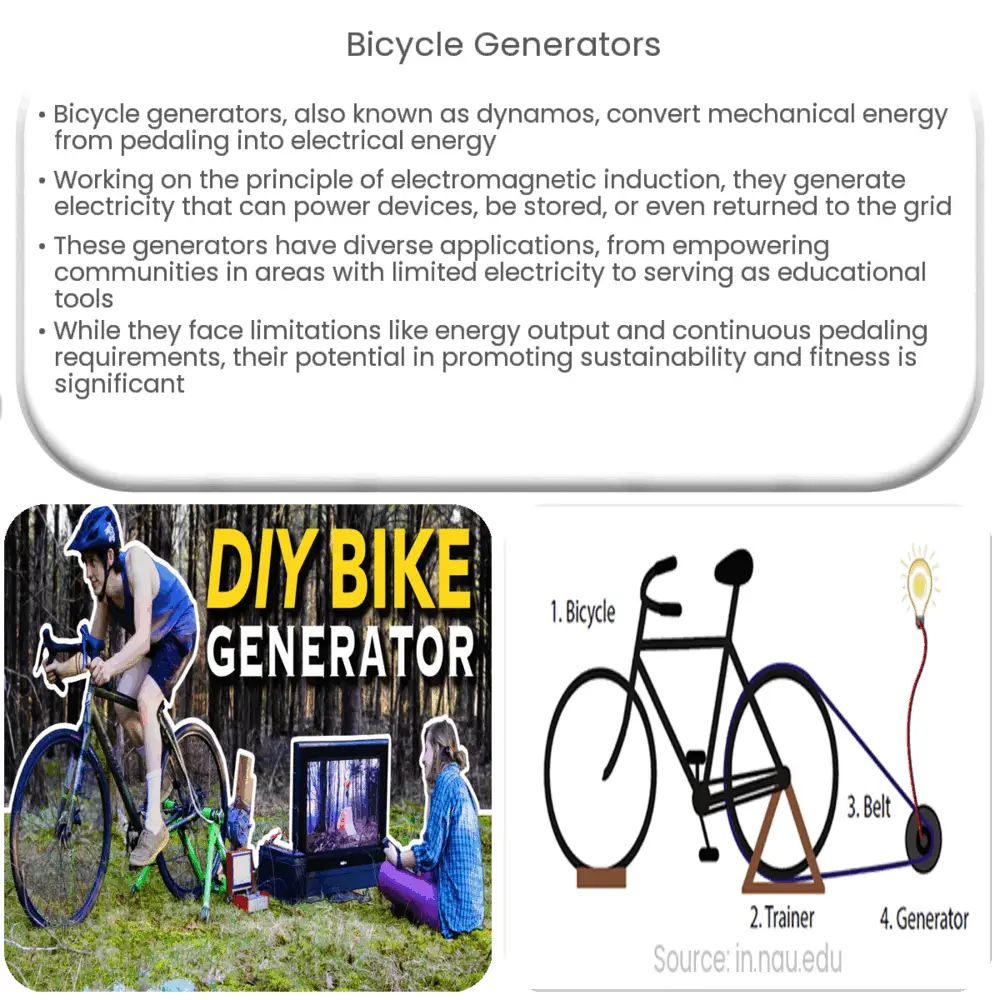Explore the world of bicycle generators: how they work, their applications, challenges, and role in promoting sustainable energy.

Understanding Bicycle Generators
A bicycle generator, often referred to as a dynamo, is a fascinating piece of technology that holds the potential to revolutionize the way we think about energy production and consumption. But what exactly is a bicycle generator? How does it work, and what can it be used for?
What is a Bicycle Generator?
At its core, a bicycle generator is a simple device that harnesses the mechanical energy produced by pedaling a bicycle, converting it into electrical energy that can be used to power various devices. The concept of bicycle generators has been around for a while, but recent advancements in technology have made them more efficient and practical for everyday use.
How Does a Bicycle Generator Work?
- The bicycle generator works on the principle of electromagnetic induction. This principle, first discovered by Michael Faraday in 1831, states that a change in the magnetic environment of a coil of wire induces a voltage in the wire.
- When the bicycle is pedaled, it turns a wheel connected to a generator, which contains a coil of wire and a magnet. As the wheel turns, it causes the magnet to move past the coil, changing the magnetic field and inducing a voltage.
- The electricity generated can then be used to power a device directly, stored in a battery for later use, or even fed back into the power grid.
Applications of Bicycle Generators
The potential uses for bicycle generators are vast and varied. For instance, they can be used in developing countries where access to electricity is limited. By installing a bicycle generator, communities can create their own power and reduce their dependence on unstable or non-existent power grids.
Bicycle generators can also be used to teach principles of physics and sustainable energy in an engaging and hands-on way. Students can learn about energy conversion, conservation, and storage while actually generating their own power.
Finally, bicycle generators offer a way to exercise and generate power at the same time. People can create their own energy while staying healthy and fit. In fact, some gyms and fitness centers are already integrating bicycle generators into their equipment, allowing users to generate electricity while they work out.
Please note that the effectiveness and efficiency of a bicycle generator can vary greatly depending on the design and the physical effort of the user. The type of generator, the bike’s mechanical setup, and the cyclist’s stamina and pedaling speed all play a role.
Emerging Developments in Bicycle Generators
With growing interest in renewable energy sources and sustainability, there’s been a surge in the development and improvement of bicycle generators. A notable trend is the development of more efficient, compact, and lighter generators that can be easily integrated into the bicycle’s structure without hindering its performance.
Many bicycle generator kits available today can be installed at home, and some even allow for the charging of USB devices. This means you could theoretically charge your phone, GPS, or other portable devices while on a long cycling trip.
Bicycle Generators and Sustainability
Bicycle generators aren’t just a cool gadget or a practical tool – they’re also a step towards a more sustainable future. Using a bicycle generator reduces the reliance on fossil fuels, cutting down on greenhouse gas emissions. Furthermore, they promote a more active lifestyle, contributing to public health benefits.
Potential Challenges and Limitations
- While bicycle generators are a promising innovation, they do come with their own set of challenges. One key limitation is the amount of energy that a single person can generate. Even a very fit cyclist can only produce a small amount of electricity compared to traditional power sources.
- Another challenge is the need for continuous pedaling to generate power. This makes it difficult to use bicycle generators as a consistent source of power for larger electrical devices or systems.
- Lastly, the upfront cost and installation of a bicycle generator system can be prohibitive for some. Despite these limitations, the potential benefits make it a worthwhile consideration for many.
Conclusion
In conclusion, bicycle generators represent a versatile, renewable source of energy that blends physical fitness with sustainability. While they may not replace conventional power sources, they offer a valuable supplement, especially in areas where electricity is scarce or unreliable. They serve as an effective teaching tool, offering hands-on lessons about physics and sustainable energy. As technology continues to advance, we can expect to see bicycle generators becoming more efficient and widely used.
Whether you’re a cycling enthusiast, a sustainability advocate, or simply someone who loves innovative solutions, bicycle generators offer a unique way to generate power, stay fit, and promote a more sustainable world.


